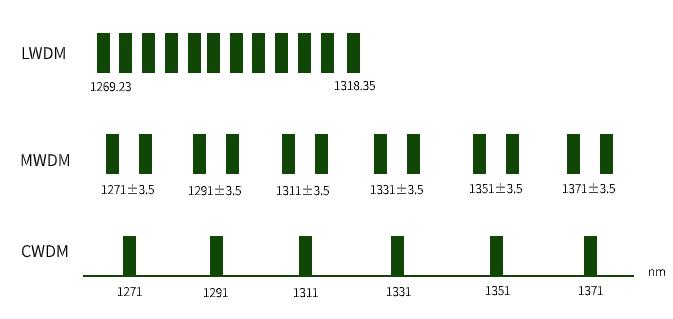Fiber Optic Tech
Types of WDM Technologies
WDM Wavelength Division Multiplexing technology is the preferred solution for 5G fronthaul network. According to different wavelengths, it can be divided into DWDM dense wavelength division multiplexing, CWDM coarse wavelength division multiplexing, FWDM filter wavelength division multiplexing, MWDM medium wavelength division multiplexing and LWDM lan wavelength division multiplexing. CWDM and DWDM are the most common use.
CWDM (Coarse WDM) is a coarse wavelength division multiplexing technology for the access layer of the metropolitan area network. It has 18 different wavelength channels, and the different wavelengths of each channel are separated by 20nm. The wavelength range is 1270 nm-1610 nm. The wavelengths belong to five bands of a single mode optical fiber system, including O, E, S, C, and L. CWDM system can increase the transmission capacity of the optical fiber in the construction of the metropolitan area network, improve the utilization of optical fiber resources, and thus reduce the operating cost of the network.
DWDM (Dense WDM) is a dense wavelength division multiplexing technology, and the channel spacing is 1.6/0.8/0.4 nm (200GHz/100 GHz/50 GHz). Compared with CWDM, DWDM with tighter wavelength spacing can carry 8 to 160 wavelengths on a single fiber, making it more suitable for long-distance transmission. The current DWDM system can provide single-fiber transmission capacity of 16/20 waves or 32/40 waves, with a maximum of 160 wave. It’s more suitable for long-distance transmission. Meanwhile, it can save optical fiber resources and reduce the cost greatly.
FWDM (Filter WDM) is a filter-type wavelength division multiplexing technology, based on mature thin-film filter technology, which can combine or separate light of different wavelengths in a wide wavelength range. It has characteristics of wide channel bandwidth, low insertion loss, high channel isolation, and high environmental stability and reliability. It is widely used in erbium-doped fiber amplifier (EDFA), Raman fiber amplifier (RFA) and single-mode fiber communication systems.

MWDM (Metro WDM) is a medium wavelength division multiplexing technology, which reuses the first 6 waves of CWDM, compressing the 20nm wavelength interval of CWDM to 7nm. MWDM uses TEC (Thermal Electronic Cooler) temperature control technology to achieve 1 wave expansion to 2 waves. That is, it is extended to 12 waves (1267.5, 1274.5, 1287.5, 1294.5, 1307.5, 1314.5, 1327.5, 1334.5, 1347.5, 1354.5, 1367.5, 1374.5nm) with a left and right offset of 3.5nm. MWDM not only reuses the CWDM industry chain, but also meets the 10km fronthaul distance requirement, and can further save optical fibers while achieving capacity improvement.
LWDM (LAN WDM) is a wavelength division multiplexing Lan-WDM technology based on Ethernet channels, with channel spacing of 200 to 800 GHz, between DWDM (100 GHz, 50 GHz) and CWDM (about 3 THz). It uses 12 wavelengths located in the O band range from 1269 nm to 1332 nm. The working wavelength is characterized by small dispersion and good stability. The wavelength spaceing is 4nm, mainly covering 10km.



















